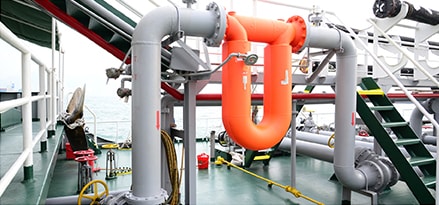ExxonMobil Premium HDME 50™
Introduction
This technical topic helps to explain global emission legislation, which is reducing allowable sulphur levels in marine fuels. One of the outcomes of this legislation is increased use of distillate fuel in marine applications. Additionally, industry analysts predict a global increase in demand of distillates across all sectors. With this in mind, ExxonMobil scientists and engineers have developed a new grade of marine fuel that will assist vessel operators in complying with the ECA 0.10 per cent sulphur limit. This new fuel is a hybrid that combines desirable qualities of both existing distillate and residual fuels.
Product overview
ExxonMobil Premium HDME 50™ fuel helps engineers to safely and efficiently operate their main and auxiliary engines and boilers. It has the performance benefits associated with both marine gas oil (MGO) and heavy fuel oil (HFO):
- A low sulphur content associated with MGO
- The higher flashpoint and lower volatility properties typically found in HFO
The properties of ExxonMobil Premium HDME 50 fuel allow marine operators to simultaneously:
- Comply with the ECA sulphur cap
- Reduce the risk of engine and boiler damage
Features and benefits
One of the key advantages of this new fuel is that it has a higher viscosity than DMA. The higher viscosity eases fuel switchover operations, optimizes proper injection viscosity and fuel atomization, and results in increased engine operational efficiency. Some operators have installed chillers in their fuel systems to increase the viscosity of DMA, which would not be required with this new fuel. The lubricity characteristics of this product exceed standards so no lubricity additive is required. Since it is highly paraffinic in nature, the new fuel has better ignition characteristics compared to typical residual fuel. These characteristics will ensure peak combustion and minimize wear on internal moving parts within the fuel system that rely on the fuel for lubrication.
Since the pour point of ExxonMobil Premium HDME 50 fuel is higher than distillate fuels, the product is required to be stored in heated tanks and treated in heated fuel systems. Although this is a hybrid fuel and combines the characteristics of both distillate and some residual grade fuels, it does not have some of the negative aspects normally associated with residual fuel. For example, ExxonMobil Premium HDME 50 fuel typically does not have any cat fines, metal contaminants or sediment issues.
Trials
Onboard trials of this fuel in four-stroke, medium-speed auxiliary engines, as well as two-stroke, slow-speed main engines, revealed no issues or operational concerns. These trials were conducted with engine manufacturer representatives in attendance in conjunction with classification societies review. OEM documentation is available upon request.
During this trial period, ExxonMobil Premium HDME 50™ fuel was also tested in auxiliary boilers to ensure no operational problems or adjustments were required of boiler automation to consume this fuel. Higher flash point of the new fuel compared to DMA lessens concerns of auxiliary boiler furnace explosions. Purifier operation was closely monitored to ensure that the fuel could be properly purified onboard with modern purifier technology.
Compatibility
Like all marine fuel there is a risk of incompatibility when commingling fuels. During testing, compatibility issues were identified with certain fuels dependent on crude streams and sulphur levels. These were identified as a level 2 on the standard compatibility spot test, ASTM D4740.
When commingled with low volumes of residual fuel, precipitation of asphaltenes may occur. Since it is difficult for vessel operators to identify components of previous bunkered fuels, limiting commingling of the new fuel and existing low-sulphur residual fuel to 2 per cent or less will reduce possible compatibility issues. Additionally, this segregation will ensure compliance with ECA sulphur limits. There were no compatibility issues noted with gas oil and the new fuel.
Volumetric energy content of ExxonMobil Premium HDME 50 fuel is typically better than DMA due to the higher density of the new product. This provides an added safety margin when full load operations would not be attainable when operating on DMA.


